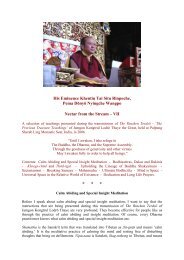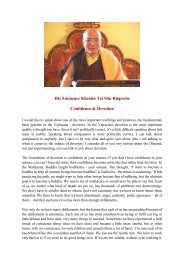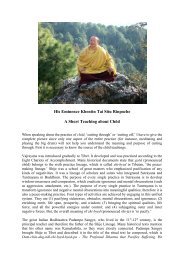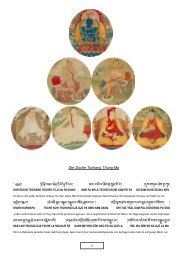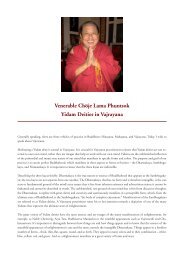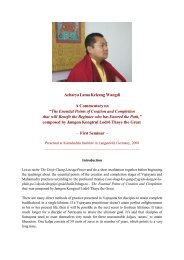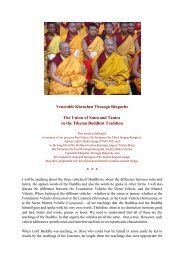Acharya Lama Kelzang Wangdi White Arya Tara - Karma Sherab Ling
Acharya Lama Kelzang Wangdi White Arya Tara - Karma Sherab Ling
Acharya Lama Kelzang Wangdi White Arya Tara - Karma Sherab Ling
You also want an ePaper? Increase the reach of your titles
YUMPU automatically turns print PDFs into web optimized ePapers that Google loves.
Translator: “One <strong>Lama</strong> told me that he was a child in Tibet when the Chinese came. He said<br />
it was a little bit heavy for them that the Chinese were there, spitting at them, laughing over<br />
them, and asking them, ‘Where is your Vajrapani who helps you now?’ It was heavy for them<br />
because it is an inner process.”<br />
<strong>Lama</strong> <strong>Kelzang</strong>: Yes, an inner process. We have an inner voice. It cannot be found physically.<br />
If our inner voice is strong, then we aren’t scared of anyone. If we don’t have it, then we are<br />
really terrified.<br />
Translator: “But we don’t blame <strong>Tara</strong> when something is happening that isn’t nice.”<br />
<strong>Lama</strong> <strong>Kelzang</strong>: That means you don’t have confidence in yourself and, because you think she<br />
is somewhere else, you don’t think that <strong>Tara</strong> is protecting you. If we think, “<strong>Tara</strong> is really<br />
protecting me,” there’s no reason to blame. Our real protection is our confidence. The stage of<br />
taking refuge is looking outwards to make our inside stronger, like a reflection in a mirror.<br />
When our mother is nearby, we are just as I explained.<br />
The practice of absolute Bodhicitta is formulated in the mantra that we repeat with<br />
wholehearted dedication:<br />
/ OM SHUNYATA JNANA VAJRA SVABHAVA ETMAKO AHAM //<br />
The syllable OM commences most mantras that we repeat while engaging in Sadhana<br />
practices. It includes everything. SHUNYATA is the Sanskrit term that means ‘emptiness.’<br />
JNANA means ‘primordial, pristine wisdom,’ which we aspire to develop. VAJRA is<br />
translated as ‘diamond sceptre.’ While having the quality of being indestructible, invincible,<br />
permanent, stable, and peaceful, a vajra is like a magical weapon that can destroy anything.<br />
SVABHAVA means ‘the true nature.’ ETMAKO means ‘self-arisen,’ i.e., not created by<br />
anything. AHAM is the Sanskrit term for ‘I am.’ We spoke about identifying ourselves, which<br />
is the meaning of AHAM. It’s very important in Vajrayana to understand the literal meaning<br />
of the words of a mantra. Then we go deeper and deeper. We have a literal meaning, a general<br />
meaning, and a secret or inner meaning of the syllables of a mantra that we learn to appreciate<br />
when we advance in our practice.<br />
The term SHUNYATA in the mantra of absolute Bodhicitta is the meditation practice of<br />
resting relaxed in the non-conceptual, peaceful moment of emptiness. All mundane,<br />
conceptual ways dissolve when we just rest in the presence of the moment. As I said earlier,<br />
nothing is missing and everything is present when we rest in the peaceful moment of our<br />
mind. We then simply have no more concepts or ideas, but have another situation. This<br />
moment of emptiness isn’t a void, as though we had to empty a bowl of water to create it.<br />
When we rest in peace, everything is there and we don’t create anything with our thoughts. In<br />
the practice of a Bodhisattva, we have to do many things, whereas everything is present when<br />
we rest in emptiness. It isn’t necessary to exert effort to experience absolute Bodhicitta<br />
because it isn’t a product, i.e., it isn’t compounded and it isn’t like an everlasting substance.<br />
The experience of absolute Bodhicitta is peace, and more peace cannot be found other than in<br />
shunyata. It never changes and is permanent. We might not be in the state of the moment, so<br />
we need to experience it.<br />
SVABHAVA is the true nature of everything and we can refer to it as “It’s like that.” For<br />
example, the moment we are at peace, we are in the state of our own identity. Sometimes we<br />
lose our identity and then act different than our true nature, e.g., more creative, more<br />
ideological, more conceptual. Then we feel uncomfortable. For example, we naturally walk<br />
forwards and not backwards, in which case we don’t feel comfortable. ETMAKO refers to<br />
absolute or ultimate reality, which is like that. If we ask, “What’s my reality?” That’s it – the<br />
10



